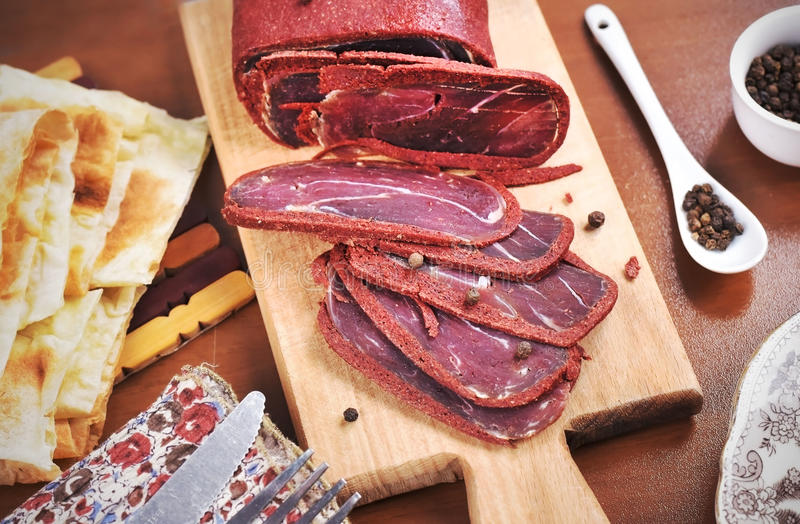Return
Gastronomy » Cookery & Pastry
Viewed 1269 times
|
Ref ID: 1GC2018/4413 | Posted On: 01-01-2018 | Updated on: 02-01-2018
|
|
Basturma - The Hirshon Armenian Dried Spiced Beef
Armenian
Published by
ArthurPirlian
This cured meat (basturma) or as we call it in Armenian: Ապուխտ (apukht) may be the most popular and well known Armenian appetizer. We make it on regular basis, but mostly it’s made before the New Year. Cured meat ( apukht) is one of the “must” appetizers for our New Year table.
The entire process of making this kind of cured meat is very simple, and takes from 7-10 days overall. However, that many take up to a month to make this delicious appetizer, depending on temperature and methods they’d use to prepare it.
Basturma (Armenian: ապուխտ apukht) is highly seasoned, air-dried raw beef, similar to bindenfleisch. The residents of Karin (Կարին, modern name Erzurum) were known to be proficient in the making of this delicacy.
The first recorded mention of Basturma was between 95-45 BC in Armenia during the reign of Tigranes the Great. It is believed that the technology of air-drying meats was first developed to preserve basturma being traded from Armenia to China and India.
During the Byzantine period, it was called apokt. One story gives its origins as the city of Caesarea (modern Kayseri), where there was a Byzantine dish called pastón, which would be translated as “salted meat” and was apparently eaten both raw and cooked in stews.
Armenians were known throughout the Levant as the most skilled makers of basturma. In Caesarea (Kayseri), the production of basturma was entirely run by Armenians. The Armenian family name of Basturmajian was held by families that processed the meat. Some authors claim that the medieval Central Asian nomad traditions to modern production of pastirma during the Ottomans is an extension of that older tradition.
The word has been borrowed into other languages of the region: Albanian: pastërma, Arabic: بسطرمة (basṭirma), Armenian: բաստուրմա (basturma), Azerbaijani: bastırma, Bosnian, Croatian and Serbian pastrma, Bulgarian: пастърма (pastărma), Greek: παστουρμάς (pastourmás), Hebrew: פסטרמה (pastrama) and Romanian: pastrámă. The American cured meat product pastrami has its origins in pastirma via Yiddish: פאסטראמא pastrama.
Pulitzer Prize-winning food critic Jonathan Gold wrote of basturma in the December 1999 issue of LA Weekly:
The Armenian cured beef called basturma may be the most powerfully flavored cold cut in the world, less a foodstuff than a force of nature, with a bit of the chewy translucence of first-rate Italian bresaola, a ripe, almost gamey back taste, and then – pow! – the onslaught of the seasoning, a caustic, bright-red slurry of hot pepper, fenugreek, and a truly heroic amount of garlic that hits the palate with all the subtle elegance of a detonated land mine.
Pastirma is prepared by salting the meat, then washing it with water and letting it dry for ten to 15 days. After that the blood and salt is squeezed out of the meat which is then covered with a cumin paste called çemen (lit. “fenugreek”) prepared with crushed cumin, fenugreek, garlic, and hot paprika, followed by thorough air-drying. Even though beef is the most common meat today, various meats are also used depending on locality, including camel, lamb, goat, and water buffalo.
The traditional Armenian pastirma strictly uses beef as the meat and this remains as the most common usage.
The Armenians introduced pastirma to Syria and Lebanon in great quantities, and it is usually served as a meze in thin slices, usually uncooked, but sometimes lightly grilled or added to eggs for breakfast. It may be added to different dishes, the most famous of which is a bean dish, and various pies.
My version of this remarkable dish hews closely to tradition (but only ages for less than a week), as befits a recipe with thousands of years of tradition behind it. I hope you will try this incredibly delicious recipe for yourselves, my Citizens!
Battle on – The Generalissimo
The entire process of making this kind of cured meat is very simple, and takes from 7-10 days overall. However, that many take up to a month to make this delicious appetizer, depending on temperature and methods they’d use to prepare it.
Basturma (Armenian: ապուխտ apukht) is highly seasoned, air-dried raw beef, similar to bindenfleisch. The residents of Karin (Կարին, modern name Erzurum) were known to be proficient in the making of this delicacy.
The first recorded mention of Basturma was between 95-45 BC in Armenia during the reign of Tigranes the Great. It is believed that the technology of air-drying meats was first developed to preserve basturma being traded from Armenia to China and India.
During the Byzantine period, it was called apokt. One story gives its origins as the city of Caesarea (modern Kayseri), where there was a Byzantine dish called pastón, which would be translated as “salted meat” and was apparently eaten both raw and cooked in stews.
Armenians were known throughout the Levant as the most skilled makers of basturma. In Caesarea (Kayseri), the production of basturma was entirely run by Armenians. The Armenian family name of Basturmajian was held by families that processed the meat. Some authors claim that the medieval Central Asian nomad traditions to modern production of pastirma during the Ottomans is an extension of that older tradition.
The word has been borrowed into other languages of the region: Albanian: pastërma, Arabic: بسطرمة (basṭirma), Armenian: բաստուրմա (basturma), Azerbaijani: bastırma, Bosnian, Croatian and Serbian pastrma, Bulgarian: пастърма (pastărma), Greek: παστουρμάς (pastourmás), Hebrew: פסטרמה (pastrama) and Romanian: pastrámă. The American cured meat product pastrami has its origins in pastirma via Yiddish: פאסטראמא pastrama.
Pulitzer Prize-winning food critic Jonathan Gold wrote of basturma in the December 1999 issue of LA Weekly:
The Armenian cured beef called basturma may be the most powerfully flavored cold cut in the world, less a foodstuff than a force of nature, with a bit of the chewy translucence of first-rate Italian bresaola, a ripe, almost gamey back taste, and then – pow! – the onslaught of the seasoning, a caustic, bright-red slurry of hot pepper, fenugreek, and a truly heroic amount of garlic that hits the palate with all the subtle elegance of a detonated land mine.
Pastirma is prepared by salting the meat, then washing it with water and letting it dry for ten to 15 days. After that the blood and salt is squeezed out of the meat which is then covered with a cumin paste called çemen (lit. “fenugreek”) prepared with crushed cumin, fenugreek, garlic, and hot paprika, followed by thorough air-drying. Even though beef is the most common meat today, various meats are also used depending on locality, including camel, lamb, goat, and water buffalo.
The traditional Armenian pastirma strictly uses beef as the meat and this remains as the most common usage.
The Armenians introduced pastirma to Syria and Lebanon in great quantities, and it is usually served as a meze in thin slices, usually uncooked, but sometimes lightly grilled or added to eggs for breakfast. It may be added to different dishes, the most famous of which is a bean dish, and various pies.
My version of this remarkable dish hews closely to tradition (but only ages for less than a week), as befits a recipe with thousands of years of tradition behind it. I hope you will try this incredibly delicious recipe for yourselves, my Citizens!
Battle on – The Generalissimo
Click on photo to view full image or click to watch video.
Ingredients
Ingredients
- two 3lbs chunks of beef fillet, make sure the meat is fresh, never frozen
- Kosher Salt
- For chaman (fenugreek) paste spread:
- ½ cup ground fenugreek
- ¼ cup Hungarian sweet paprika
- ¼ cup Hungarian hot paprika
- 1 tbs cayenne
- 1 tbs freshly-ground black pepper
- 2 tsp freshly-ground cumin
- 1 ½ tbs kosher salt
- 1 ¼ cups water
- 10 large cloves garlic
- 9”x13” baking pan to hold the meat
Instruction
For the cured meat:
- Begin by prepping the meat: wash, cut and remove all additional fats and parts you don’t want.
- Using a pointy skewer or thick pin, make a few pokes on the meat.
- Generously sprinkle the bottom of your pan with salt and place the meat in it.
- Then once again, generously sprinkle the salt all over the meats, making sure to cover them entirely.
- Cover the pans with lid or plastic wrap and place it somewhere cool for 2 days.
- Once in a while, check and see if there are parts that have absorbed all the salt – if so, add more to cover that part.
- After 2 days, wash and pat dry the meats very well.
- Wrap with a few layers of paper towel and put under a heavy press for 1 day, using whatever weighty object(s) you have hanging about.
- During that time, check and see if the paper towel is moist – if so, change and re-wrap it again with a new dry paper towel.
- Unwrap and hang the meats to dry for 2-3 days in a sunny spot with lots of air circulation. You can either use metal hooks or simple twine thread for hanging the meats.
Make the Chaman Paste:
- To make the Chaman, first combine all ingredients in a food processor. Pulse until smooth, stop and scrape down a few times.
- Generously spread the chaman paste thickly all over the meats.
- Hang to dry for another 2-3 days.
- Slice thinly and enjoy!
- Remember that ready-cured meat needs to be stored in the fridge!
Your comments
Write your comments





